Picture Gallery
This edition of the web site contains two series of pictures illustrating current activities at the Museum and the progress of the static display site. All of these activities are prerequisites to a public opening, and must be completed before train operations commence.
The first series is a set of aerial photographs taken in November, 2002. They clearly illustrate the earthworks that have taken place over the preceding months, with the bulk of the excavation to accommodate the next two roads of the display area (9 and 10 roads) almost complete, and how the excavated material is used to build up the level of the display area at its Northern end.
The second series illustrates the task of transporting the remaining items of rolling stock to Dorrigo by road. This task is a massive undertaking, with over 200 vehicles delivered to Dorrigo by road so far. The transport of all outstanding major items must be completed prior to opening, as it will be nigh on impossible to continue this task once the public are admitted to the site.
Aerial Views
This section contains anumber of pictures which illustrate the Museum site. This is an area of land tothe west of Dorrigo station itself, part of the 53 acres owned by the Museum. Aportion of this area is being levelled, using the Museum's own resources, to formthe static display area. Eventually, a display building will be erected, instages, on this site to keep the majority of the collection under cover andprotected from the weather, as well as allowing comfortable accessto the collection by the public.
 Thefirst photograph is taken looking towards the North. The earthworks are progressing to the right, andwill eventually accommodate 16 display roads. The display roads are numbered 1 to 8,from left to right, with an extra road on the left for storage of bogies and wheelsets. This road will eventually be removed, and is approximately in the position of the west wall of the planned display building.
Thefirst photograph is taken looking towards the North. The earthworks are progressing to the right, andwill eventually accommodate 16 display roads. The display roads are numbered 1 to 8,from left to right, with an extra road on the left for storage of bogies and wheelsets. This road will eventually be removed, and is approximately in the position of the west wall of the planned display building.
There are over 200 vehicles on this site, all of which have been brought in by road, a massive achievement by the Museum.

Thesecond picture in this series is taken looking to the South, and showing the relationship between the Museum site and Dorrigo railway station, on the left. The large area of earthworks in the right foreground is where the throat pointwork for the display area will be. This pointwork will also form part of the public permanent way display, and in this area some of the more unusual track components, such as the outside slips from Pippita and the double slip from North Strathfield, will be included in the track design.
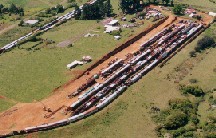 Thispicture is taken from the North West, giving a oblique view of the site. It shows the ramp at the top left hand corner of the earthworks that is left by the scraper. This ramp will be removed by the bulldozer and the backhoe, leaving a near-vertical face, thus allowing this portion of the site to be graded to it's final level, and allowing numbers 9 and 10 display roads to be laid. The vertical face of the earthworks is approximately 5 metres high at it's highest point, and will get higher still as the earthworks proceed, as the ground is still rising gently to the east of the site.
Thispicture is taken from the North West, giving a oblique view of the site. It shows the ramp at the top left hand corner of the earthworks that is left by the scraper. This ramp will be removed by the bulldozer and the backhoe, leaving a near-vertical face, thus allowing this portion of the site to be graded to it's final level, and allowing numbers 9 and 10 display roads to be laid. The vertical face of the earthworks is approximately 5 metres high at it's highest point, and will get higher still as the earthworks proceed, as the ground is still rising gently to the east of the site.
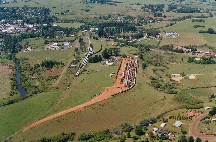 The last image in this series is also taken from the North, but from a higher altitude. It shows the embankment that leads from the display area to the branch line, on which the connecting siding will be laid. A turnout will be inserted into the branch line to allow access to this siding, so allowing stock to be freely moved between the display area and the branch line and Dorrigo station.In the top left hand corner is the township of Dorrigo itself, with the industrial area between the township and the station.
The last image in this series is also taken from the North, but from a higher altitude. It shows the embankment that leads from the display area to the branch line, on which the connecting siding will be laid. A turnout will be inserted into the branch line to allow access to this siding, so allowing stock to be freely moved between the display area and the branch line and Dorrigo station.In the top left hand corner is the township of Dorrigo itself, with the industrial area between the township and the station.
Collection Transport
This series of pictures shows some of the aspects of transporting major items of the collection to Dorrigo by road. They indicate the sheer size of some of the items, and demonstrate the capacity of the Museum's own resources, in particular the Leader prime mover and the quad-axle low loader.
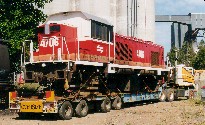 Thefirst photograph shows locomotive 4706 "ready for the road" at Newcastle just prior to the long haul to Dorrigo. The locomotive has been lifted off it's bogies (which will come on two separate trips) and is sitting on timber pigsties. This serves the dual purpose of reducing the height and weight of the locomotive to within legal limits. The efforts of the Newcastle crew are also evident. They have spent considerable time and effort in repairs to the bodywork of this locomotive, and also applied a fresh coat of paint to protect it and to enhance it's appearance.
Thefirst photograph shows locomotive 4706 "ready for the road" at Newcastle just prior to the long haul to Dorrigo. The locomotive has been lifted off it's bogies (which will come on two separate trips) and is sitting on timber pigsties. This serves the dual purpose of reducing the height and weight of the locomotive to within legal limits. The efforts of the Newcastle crew are also evident. They have spent considerable time and effort in repairs to the bodywork of this locomotive, and also applied a fresh coat of paint to protect it and to enhance it's appearance.
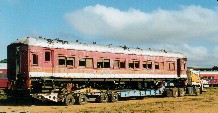
This picture shows SBX879 on arrival in Dorrigo after being loaded at Glenreagh. The length of the car requires extensions being added to the back of the float, visible in the picture. Again, the body was lifted off it's bogies to reduce the height, and is sitting on timber pigsties. One of the spreader bars used by the cranes in the loading operation is also visible on the float, above the rear axles. This car was unloaded using the Museum's own crane shortly after this picture was taken, and is now back on it's bogies.
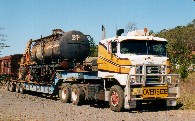 Smaller vehicles can be transported on their wheels, as a set of rails is permanently fixed to the deck of the low loader, and we have also installed a diesel powered winch. In this photo, 4-wheel tank car BP212 has been winched onto these rails from a loading ramp just visible to the rear of the truck. The short length of this wagon allows the Museum's backhoe to get a free ride back to Dorrigo, having been utilised at Glenreagh for various shunting tasks during the day.
Smaller vehicles can be transported on their wheels, as a set of rails is permanently fixed to the deck of the low loader, and we have also installed a diesel powered winch. In this photo, 4-wheel tank car BP212 has been winched onto these rails from a loading ramp just visible to the rear of the truck. The short length of this wagon allows the Museum's backhoe to get a free ride back to Dorrigo, having been utilised at Glenreagh for various shunting tasks during the day.
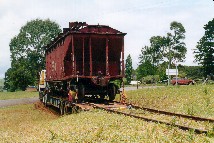 Also within height limits is bogie cement hopper NPBF29228. This picture shows the truck reversed into a specially prepared excavation at the end of the turntable road in Dorrigo yard, thus enabling it to be rolled straight off. A wagon of this length sits comfortably on the truck without the extensions being used, but leaves no space for additional loading, such as the backhoe as in the previous picture.
Also within height limits is bogie cement hopper NPBF29228. This picture shows the truck reversed into a specially prepared excavation at the end of the turntable road in Dorrigo yard, thus enabling it to be rolled straight off. A wagon of this length sits comfortably on the truck without the extensions being used, but leaves no space for additional loading, such as the backhoe as in the previous picture.
(*) -All pictures are Copyright 2003 Dorrigo Steam Railway and Museum Limited
 Thefirst photograph is taken looking towards the North. The earthworks are progressing to the right, andwill eventually accommodate 16 display roads. The display roads are numbered 1 to 8,from left to right, with an extra road on the left for storage of bogies and wheelsets. This road will eventually be removed, and is approximately in the position of the west wall of the planned display building.
Thefirst photograph is taken looking towards the North. The earthworks are progressing to the right, andwill eventually accommodate 16 display roads. The display roads are numbered 1 to 8,from left to right, with an extra road on the left for storage of bogies and wheelsets. This road will eventually be removed, and is approximately in the position of the west wall of the planned display building.





